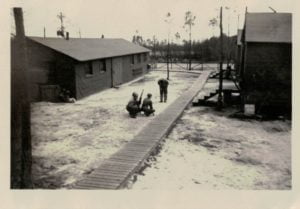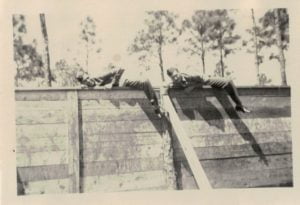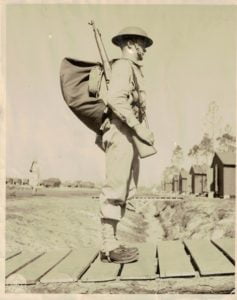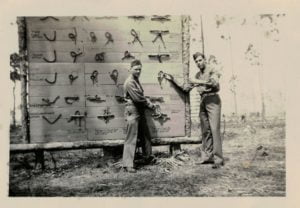The original organization of the Amphibious Training Center provided for a Commanding Officer, Executive Officer, Provisional Headquarters Detachment, Staff Section, Faculty Section, and the 75th Composite Infantry Training Battalion which was the demonstration unit for the Center. The 75th had been activated on 15 June 1942, and was one of the first units to arrive at Camp Gordon Johnston. It consisted of one rifle battalion headquarters and headquarters company, one rifle company, one heavy weapons company, a battalion medical detachment, and a composite field artillery battery which had two 105 mm howitzers and two 155 mm howitzers. The Operations Officer was charged with the duties incident to planning, preparation, and conduct of training.
Camp Gordon Johnston was large enough to house simultaneously the entire student division reinforced, the Engineer Amphibian Brigade, the station complement, and the personnel of the Amphibious Training Center including the 75th Composite Infantry Training Battalion. There was sufficient ground space available to permit the training of an entire division at one time, and accordingly the previous system of training combat teams in succession was abandoned. Both student divisions at Carrabelle were trained as reinforced division units and not as separate combat teams.
For in-depth information on the 75th, please see: The Army Ground Forces: The Amphibious Training Center, by Capt. Marshall O. Becker (1946) at this link:
The personnel of the Amphibious Training Center were later scattered to the four winds. Some of them were released for reassignment to combat units and others were retained for the conduct of further amphibious training under the supervision of the Navy.
General Keating left the Center in late March 1943 for duty as Senior Officer in Force Headquarters Section (Army) of the Amphibious Training Command, U. S. Atlantic Fleet, at Norfolk, Virginia. Shortly after assumption of his new duties he began to call for officers who had worked with him at the Center, some of whom were placed on duty at Norfolk and Camp Bradford, Virginia, and some at Fort Pierce, Florida, where the Navy had amphibious training installations in operation.
The personnel of Headquarters Detachment, both officers and enlisted men, who were not needed for further work with the Navy were transferred to the station complement of Camp Gordon Johnston awaiting reassignment by Army Ground Forces. They were subsequently assigned to a number of newly activated divisions, service schools, or replacement pools.
The 75th Composite Infantry Training Battalion was transferred intact to Camp Pickett, Virginia, and assigned to Force Headquarters Section (Army), Amphibious Training Command, U. S. Atlantic Fleet, for further duty as demonstration troops. The Battalion left Camp Gordon Johnston on 7 June 1943 and arrived at Camp Pickett two days later.
The period from arrival at Camp Pickett until July 22 was spent in getting settled at the new camp and in basic training of the personnel of the Battalion. No plans had as yet been made for the employment of the unit in Navy ship-to-shore training.
On 22 July the Battalion was ordered to Camp Bradford for indoctrination in ship-to-shore amphibious training in order that it might better fulfill its new mission. It stayed at Camp Bradford until 5 August, when it was ordered back to Camp Pickett and directed to open a basic amphibious school for a number of separate battalions and smaller unite by 10 August. This school was to consist of a brief indoctrination for selected officers and noncommissioned officers and a course for the unit staffs.
It was the same story all over again—a requirement to start a school in five days when there was very little with which to work. Fortunately, when the Amphibious Corps Atlantic Fleet had been at Camp Pickett from August to October 1942, it had built cargo-net towers and mock-up boats in three separate areas. After considerable repair these training aids were used by the 75th Composite Infantry Training Battalion in the conduct of its school.
Most of the officers of the Battalion had never previously acted as instructors, since their duties had been only to demonstrate or to supervise training. They nevertheless prepared conferences for the first school, which started on 10 August as directed. The units trained during the month of August at Camp Pickett included a quartermaster service battalion, a railhead company, an ordnance ammunition service platoon, a military police company (corps) and an antiaircraft battalion. Ten days of training were offered in the school—five days of classroom work and five days of practical work in the training areas.
On 7 September 1943, the 75th Composite Infantry Training Battalion, less Heavy Weapons Company, was ordered back to Camp Gordon Johnston, Florida, to reopen the camp for the purpose of training the 4th Infantry Division in ship-to-shore operations under supervision of the Navy. Training started on 1 October 1943, and ran until 30 November, at which time the camp was again closed so far as amphibious training was concerned, and the Battalion was ordered back to Camp Pickett.
In the meantime, the Heavy Weapons Company, which had been left at Camp Pickett, carried on the basic training school at that station. The school was supervised by a detachment of three officers (Lt. Col. McGinn, Maj. Stare, and Capt. Stout) who had been sent over from the Navy Training Center at Camp Bradford for the purpose. Lt. Col. McGinn and Capt. Stout were former members of the Amphibious Training Center at Camp Edwards and at Camp Gordon Johnston.
The first school under the Amphibious Training Detachment at Camp Pickett (as the Heavy Weapons Company plus the detachment of officers from Bradford was designated) opened on 10 September. Training was carried on continually, officers and men working seven days a week, until 16 December 1943. During that time the small detachment of ten officers (seven from Heavy Weapons Company) and 160 enlisted men trained the 31st Infantry Division reinforced, and the 77th Infantry Division, plus twelve separate battalions of antiaircraft, tanks, and tank destroyers. Ten days of training were given each regimental combat team of the divisions and each separate battalion. The large number of units trained in the short period of time necessitated overlapping of the schools so that while one unit was taking its five days of practical work in the field, the neat unit was receiving its staff school. Upon completion of their basic training at Camp Pickett, units moved to Camp Bradford, Virginia, for further training involving the use of actual landing craft, and for operations on transports in the Solomons Island area of Chesapeake Bay.
The training for the last combat team of the 77th Infantry Division was completed on 16 December 1943. By that date all elements of the 75th Composite Infantry Training Battalion were reassembled at Camp Pickett. Army Ground Force orders disbanded the Battalion as of 10 December 1943, and assigned all officers and enlisted men to XIII Corps for reassignment to the 77th Infantry Division. The latter unit had completely absorbed the officers and men of the Battalion by the end of December. The dissolution of the 75th Composite Infantry Training Battalion ended the life of the last remaining element of the Amphibious Training Centers.
It appears that the men were assigned to other infantry regiments before being deployed. One such soldier was James B. Chitty of Missouri, who fought with company A of the 109th Infantry Regiment, 28th Infantry Division.




